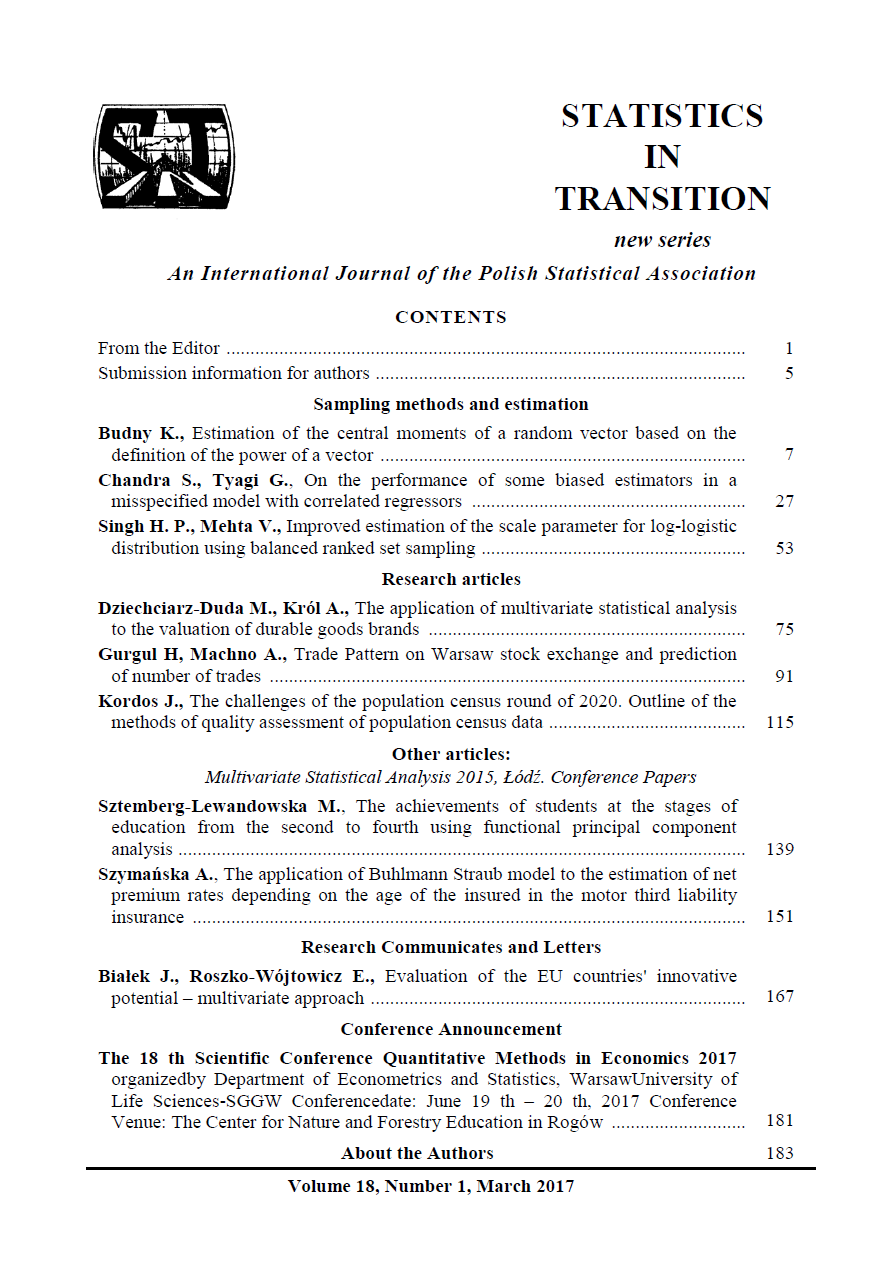ARTICLE
ABSTRACT
The main goal of this paper is to present the method for describing and predicting trade intensity on the Warsaw Stock Exchange. The approach is based on generalized linear models, the variable selection is performed using shrinkage methods such as the Lasso or Ridge regression. The variable under investigation is the number of trades of a particular stock 5-minute interval. The main conclusion is that the number of trades during short intervals is predictable in the sense that the prediction, even based on relatively simple models, is with respect to statistical properties better than the prediction based on the random walk, which is used as a benchmark model
KEYWORDS
high frequency data, daily trade pattern, Warsaw Stock Exchange, market microstructure
REFERENCES
BAUWENS, L.,GIOT., P., (2000). The logarithmic ACD model: An application to the bid–ask quote process of three NYSE stocks, “Annales D’economie Et De Statistique”, 60, pp. 117–149.
BAUWENS, L.,HAUTSCH, N., (2009). Modelling financial high frequency data using point processes, pp. 953–979, Berlin: Springer.
CARTEA, Á., JAIMUNGAL, S., (2013). Modelling Asset Prices for Algorithmic and High-Frequency Trading, “Applied Mathematical Finance”, Vol. 20, No. 6, pp. 512–547.
CARTEA, Á., MEYER-BRANDIS, T., (2010). How duration between trades of underlying securities affects option prices, “Review of Finance”, 14 (4), pp. 749–785.
de JONG, F., RINDI, B., (2009). The microstructure of financial markets (1st ed.), Cambridge: Cambridge University Press.
DIAMOND, D. W.,VERRECHIA, R. E., (1987). Constraints on short-selling and asset price adjustment to private information, “Journal of Financial Economics”, 18, pp. 277–311.
DUFOUR, A., ENGLE, R. F., (2000). Time and the price impact of a trade, “The Journal of Finance”, LV (6), pp. 2467–2498.
EASLEY, D., O’HARA, M., (1992). Time and the process of security price adjustment, “The Journal of Finance”, XLVII (2), pp. 577–605.
ENGLE, R. F., (2000). The econometrics of ultra-high-frequency data, ”Econometrica”, 68 (1), pp. 1–22.
ENGLE, R. F., RUSSELL, J. R., (1998). Autoregressive conditional duration: A new model for irregularly spaced transaction data,” Econometrica”, 66 (5), pp. 1127–1162.
FERNANDES, M., GRAMMIG, J., (2005). Nonparametric specification tests for conditional duration models, “Journal of Econometrics”, 127 (1), pp. 35–68.
FRIEDMAN, J., TIBSHIRANI, R., HASTIE, T., (2010). Regularization Paths for Generalized Linear Models via Coordinate Descent, “Journal of Statistical Software”, Vol. 33, No. 1. http://www.jstatsoft.org/v33/i01.
HASTIE, T., TIBSHIRANI, R., FRIEDMAN, J., (2008).The Elements of Statistical Learning, 2nd edition, Springer, New York.
HUJER, R., VULETIC, S., KOKOT, S., (2002). The Markov switching ACD model, SSRN eLibrary, Retrieved from http://ssrn.com/abstract=332381.
MAHEU, J. M., MCCURDY, T. H., (2000). Volatility dynamics under duration dependent mixing, “Journal of Empirical Finance”, 7 (3–4), pp. 345–372.
MANGANELLI, S., (2005). Duration, volume and volatility impact of trades, “Journal of Financial Markets”, 8 (4), pp. 377–399.
MEITZ, M., TERASVIRTA, T., (2006). Evaluating models of autoregressive conditional duration, “Journal of Business & Economic Statistics”, 24, pp. 104–124.
RENAULT, E., VAN DER HEIJDEN, T.,WERKER, B. J. M., (2012). The dynamic mixed hitting-time model for multiple transaction prices and times, Working Paper, Retrieved fromhttp://dx.doi.org/10.2139/ssrn.2146220.
TIBSHIRANI, R., (1996). Regression Shrinkage and Selection via the Lasso, “Journal of the Royal Statistical Society, Series B”, Vol. 58, No. 1, pp. 267–288.
ZHANG, M. Y., RUSSELL, J. R., TSAY, R. S., (2001). A nonlinear autoregressive conditional duration model with applications to financial transaction data, “Journal of Econometrics”, 104 (1), pp. 179–207.
ZOU, H., HASTIE, T., (2005). Regularization and Variable Selection via the Elastic Net, “Journal of the Royal Statistical Society, Series B”, Vol. 67, No. 2, pp. 301–320
